Pioneered by the likes of Google and AirBnB, vector embedding has revolutionized recommendation systems by enabling more accuracy and personalization than traditional methods. By representing users and items as high-dimensional vectors in a latent space, embeddings capture similarities and relationships between users and items, and can therefore be used to provide more relevant recommendations. Their compact and dense nature facilitates efficient computation and scalability, which is vital for real-time and large-scale scenarios.
In this article, we'll walk you through how to use the Superlinked library to create an effective RecSys - specifically an e-commerce site selling mainly clothing, that can be updated in real-time employing feedback loops defined by user interactions.
While vector embeddings can vastly improve recommendation systems, effectively implementing them requires addressing several challenges, including:
Superlinked lets you address these challenges by combining all available data about users and products into rich multimodal vectors. In our e-commerce RecSys example below, we do this using the following Superlinked library elements:
By embedding our initially sparse user-specific data (the user's initial product preference), we can handle the cold-start problem. As user behavior accrues, we can go much further, hyper-personalizing recommendations by embedding this event data, creating a feedback loop that lets you update vectors with user preferences in real time. In addition, Superlinked's query time weights let you fine-tune your retrieval results, biasing them to match specific user preferences.
Let's get started.
At the start of development, we have the following product data:
We also have the following data about users and products:
Also, classical economics tells us that, on average, all users ceteris paribus prefer products that:
We can set up our Spaces to take account of this data, so that our RecSys works in cold-start scenarios - recommending items for users we know very little about. Once our RecSys is up and running, we’ll also have behavioral data: users will click on certain products, buy certain products, etc. We can capture and use this event data to create feedback loops, updating our vectors to reflect user preferences and improving recommendation quality.
First, we need to install the Superlinked library and import the classes.
%pip install superlinked==6.0.0 import altair as alt import os import pandas as pd import sys from superlinked.framework.common.embedding.number_embedding import Mode from superlinked.framework.common.schema.schema import schema from superlinked.framework.common.schema.event_schema import event_schema from superlinked.framework.common.schema.schema_object import String, Integer from superlinked.framework.common.schema.schema_reference import SchemaReference from superlinked.framework.common.schema.id_schema_object import IdField from superlinked.framework.common.parser.dataframe_parser import DataFrameParser from superlinked.framework.dsl.executor.in_memory.in_memory_executor import ( InMemoryExecutor, InMemoryApp, ) from superlinked.framework.dsl.index.index import Index from superlinked.framework.dsl.index.effect import Effect from superlinked.framework.dsl.query.param import Param from superlinked.framework.dsl.query.query import Query from superlinked.framework.dsl.source.in_memory_source import InMemorySource from superlinked.framework.dsl.space.text_similarity_space import TextSimilaritySpace from superlinked.framework.dsl.space.number_space import NumberSpace alt.renderers.enable(get_altair_renderer()) pd.set_option("display.max_colwidth", 190)
We also define our datasets, and create a constant for storing the top 10 items - see cell 3 in the notebook.
Now that the library's installed, classes imported, and dataset locations identified, we can take a look at our dataset to inform the way we set up our Spaces. Initially, we have data from user registration - i.e,. which of three products user_1 and user_2 chose. We'll use this data to solve the cold-start problem.
# the user preferences come from the user being prompted to select a product out of 3 - those will be the initial preferences # this is done in order to give somewhat personalised recommendations user_df: pd.DataFrame = pd.read_json(USER_DATASET_URL) user_df

We can also set up a close examination of the distribution data of our products - see cell 5. This gives you a picture of how many products are at different price points, have different review counts, and have different ratings (including where the majority of products lie in these ranges).

The price bins for products are mostly below the $1000 price point. We may want to set the Space range to 25-1000 to make it representative, undistorted by outlier values. Products' review counts are evenly distributed, and review ratings relatively evenly distributed, so no additional treatment is required. See cells 7-9.
Superlinked’s library contains a set of core building blocks that we use to construct the index and manage the retrieval. You can read about these building blocks in more detail here.
Let’s put this library’s building blocks to use in our EComm RecSys. First you need to define your Schema to tell the system about your data.
# schema is the way to describe the input data flowing into our system - in a typed manner @schema class ProductSchema: description: String name: String category: String price: Integer review_count: Integer review_rating: Integer id: IdField @schema class UserSchema: preference_description: String preference_name: String preference_category: String id: IdField @event_schema class EventSchema: product: SchemaReference[ProductSchema] user: SchemaReference[UserSchema] event_type: String id: IdField # we instantiate schemas as follows product = ProductSchema() user = UserSchema() event = EventSchema()
Next, you use Spaces to say how you want to treat each part of the data when embedding. In Space definitions, we describe how to embed inputs so that they reflect the semantic relationships in our data. Each Space is optimized to embed the data so as to return the highest possible quality of retrieval results. Which Spaces are used depends on your datatype.
# textual inputs are embedded in a text similarity space powered by a sentence_transformers model description_space = TextSimilaritySpace( text=[user.preference_description, product.description], model="sentence-transformers/all-distilroberta-v1", ) name_space = TextSimilaritySpace( text=[user.preference_name, product.name], model="sentence-transformers/all-distilroberta-v1", ) category_space = TextSimilaritySpace( text=[user.preference_category, product.category], model="sentence-transformers/all-distilroberta-v1", ) # NumberSpaces encode numeric input in special ways to reflect a relationship # here we express relationships to price (lower the better), or ratings and review counts (more/higher the better) price_space = NumberSpace( number=product.price, mode=Mode.MINIMUM, min_value=25, max_value=1000 ) review_count_space = NumberSpace( number=product.review_count, mode=Mode.MAXIMUM, min_value=0, max_value=100 ) review_rating_space = NumberSpace( number=product.review_rating, mode=Mode.MAXIMUM, min_value=0, max_value=4 ) # create the index using the defined spaces product_index = Index( spaces=[ description_space, name_space, category_space, price_space, review_count_space, review_rating_space, ] ) # parse our data into the schemas - not matching column names can be conformed to schemas using the mapping parameter product_df_parser = DataFrameParser(schema=product) user_df_parser = DataFrameParser( schema=user, mapping={user.preference_description: "preference_desc"} ) # setup our application source_product: InMemorySource = InMemorySource(product, parser=product_df_parser) source_user: InMemorySource = InMemorySource(user, parser=user_df_parser) executor: InMemoryExecutor = InMemoryExecutor( sources=[source_product, source_user], indices=[product_index] ) app: InMemoryApp = executor.run() # load the actual data into our system source_product.put([products_df]) source_user.put([user_df])
Now that you’ve got your data defined in Spaces, you’re ready to play with your data and optimize the results. Let's first showcase what we can do without events - our cold-start solution.
Here, we define a user query that searches with only the user's preference vector. We have configuration control over the importance (weights) of each input type (Space).
user_query = ( Query( product_index, weights={ description_space: Param("description_weight"), name_space: Param("name_weight"), category_space: Param("category_weight"), price_space: Param("price_weight"), review_count_space: Param("review_count_weight"), review_rating_space: Param("review_rating_weight"), }, ) .find(product) .with_vector(user, Param("user_id")) .limit(Param("limit")) ) # simple recommendations for our user_1 # these are based only on the initial product the user chose when first entering our site simple_result = app.query( user_query, user_id="user_1", description_weight=1, name_weight=1, category_weight=1, price_weight=1, review_count_weight=1, review_rating_weight=1, limit=TOP_N, ) simple_result.to_pandas()
The results of this query reflect the fact that user_1 chose a handbag when they first registered on our ecomm site.
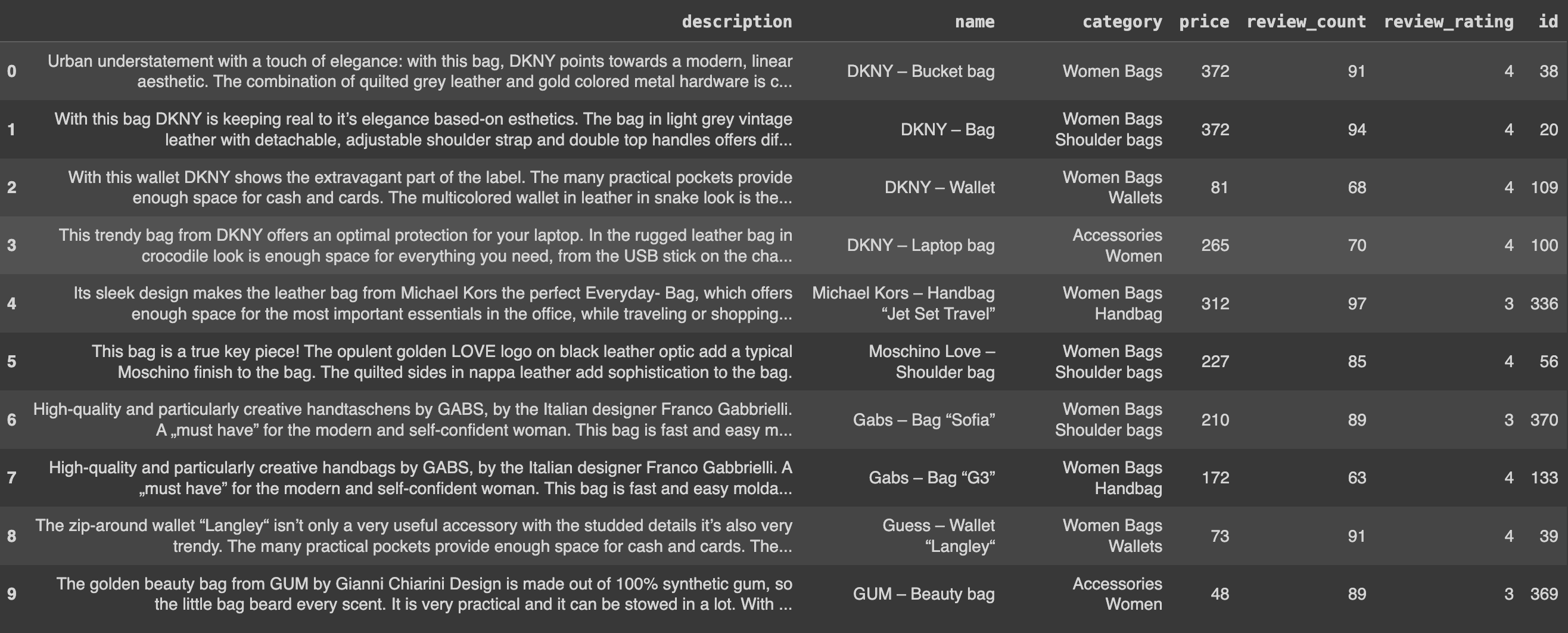
It's also possible to recommend products to user_1 that are generally appealing - that is, based on their price being low, and having a lot of good reviews. Our results will now reflect both user_1's product choice at registration and the general popularity of products. (We can also play around with these weights to skew results in the direction of one Space or another.)
general_result = app.query( user_query, user_id="user_1", description_weight=0, name_weight=0, category_weight=0, price_weight=1, review_count_weight=1, review_rating_weight=1, limit=TOP_N, ) general_result.to_pandas()
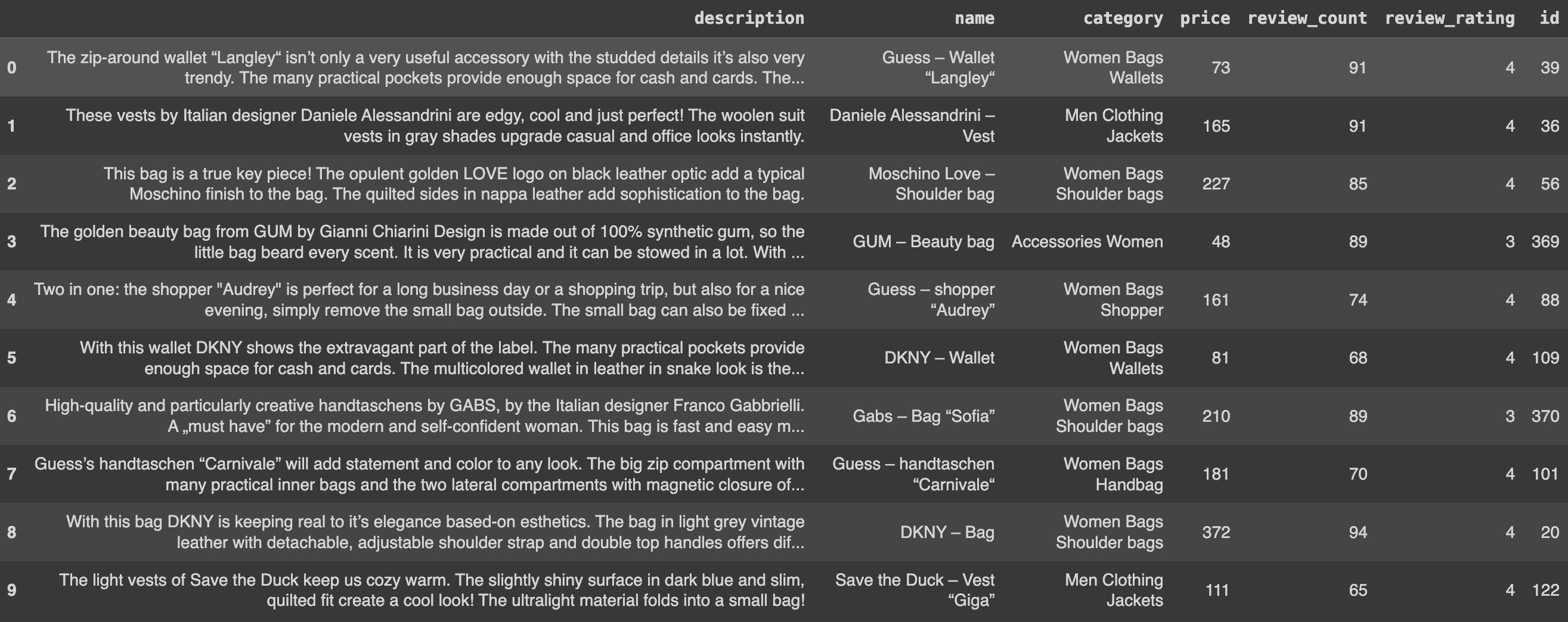
A new user's search introduces query text as an input for our recommendation results - see cell 20.
In our example case, user_1 searched for "women clothing jackets". We can optimize our results by giving additional weight to the category space (category_weight = 10), to recommend more “women clothing jackets” products.
women_cat_result = app.query( search_query, user_id="user_1", query_text="women clothing jackets", description_weight=1, name_weight=1, category_weight=10, price_weight=1, review_count_weight=1, review_rating_weight=1, limit=TOP_N, ) women_cat_result.to_pandas()
Our additional category weighting produces more women clothing results.
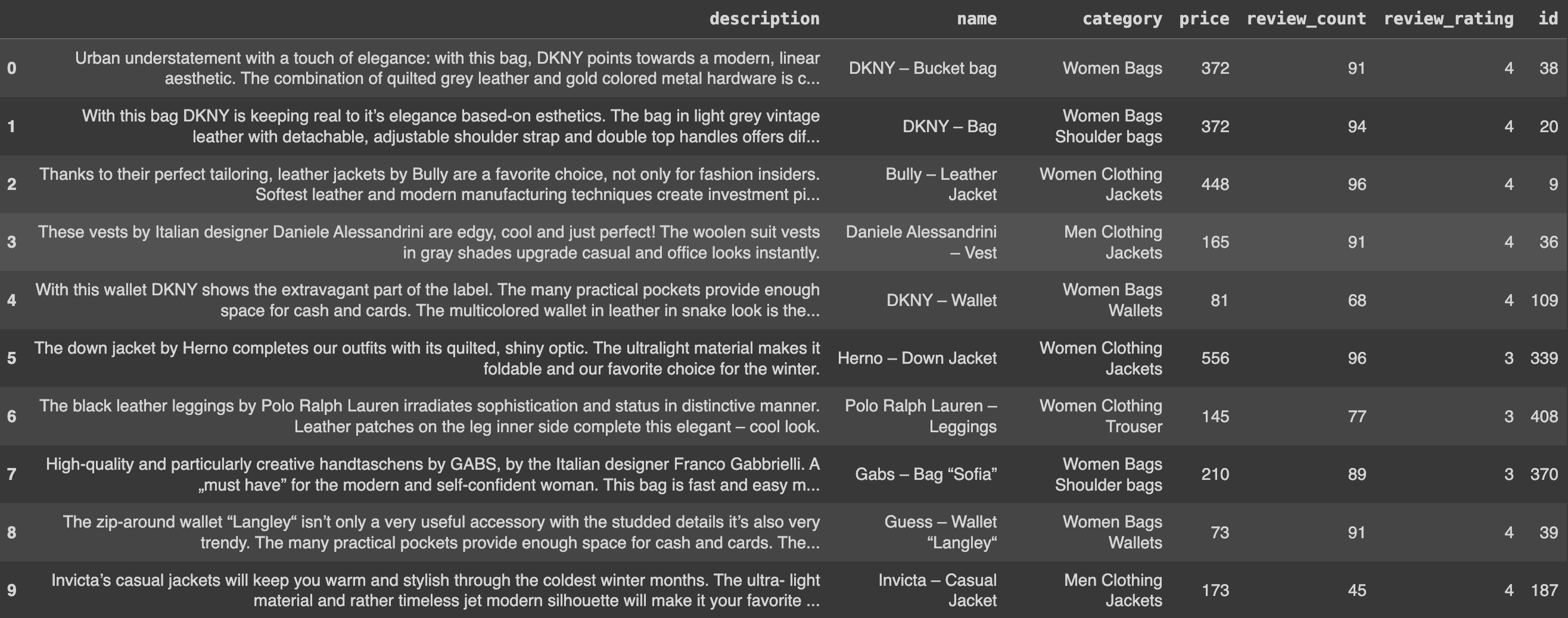
We can also bias our recommendations to top-rated products (review_rating_weight=5), balancing our increased category weighting. The results now reflect user_1's initial preference for handbags and items that are generally popular, while products with low ratings are removed altogether. See cell 22.
Fast-forward a month. Our users have interacted with our platform - user_1 more, user_2 less so. We can now utilize our users' behavioral data (see below), represented as events:
events_df = ( pd.read_json(EVENT_DATASET_URL) .reset_index() .rename(columns={"index": "id"}) .head(NROWS) ) events_df = events_df.merge( products_df[["id"]], left_on="product", right_on="id", suffixes=("", "r") ).drop("idr", axis=1) events_df = events_df.assign(created_at=1715439600) events_df
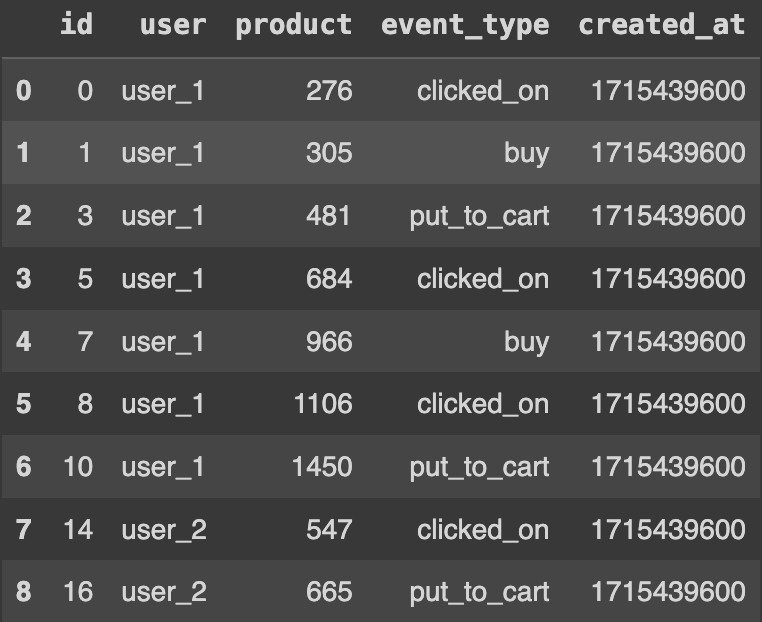
Let's weight specific actions to register the user's level of interest in a particular product, and adjust the setup to take account of events when performing retrieval.
event_weights = { "clicked_on": 0.2, "buy": 1, "put_to_cart": 0.5, "removed_from_cart": -0.5, } # adjust the setup to events product_index_with_events = Index( spaces=[ description_space, category_space, name_space, price_space, review_count_space, review_rating_space, ], effects=[ Effect( description_space, event.user, event_weight * event.product, event.event_type == event_type, ) for event_type, event_weight in event_weights.items() ] + [ Effect( category_space, event.user, event_weight * event.product, event.event_type == event_type, ) for event_type, event_weight in event_weights.items() ] + [ Effect( name_space, event.user, event_weight * event.product, event.event_type == event_type, ) for event_type, event_weight in event_weights.items() ], ) event_df_parser: DataFrameParser = DataFrameParser(schema=event) source_event: InMemorySource = InMemorySource(schema=event, parser=event_df_parser) executor_with_events: InMemoryExecutor = InMemoryExecutor( sources=[source_product, source_user, source_event], indices=[product_index_with_events], ) app_with_events: InMemoryApp = executor_with_events.run()
Now we create a new index to take account of user events, and then personalize recommendations to each user accordingly. Even queries only based on the user's vector are now much more personalized than before.
# for a new index, all data has to be put into the source again source_product.put([products_df]) source_user.put([user_df]) source_event.put([events_df]) # a query only searching with the user's vector the preferences are now much more personalised thanks to the events personalised_query = ( Query( product_index_with_events, weights={ description_space: Param("description_weight"), category_space: Param("category_weight"), name_space: Param("name_weight"), price_space: Param("price_weight"), review_count_space: Param("review_count_weight"), review_rating_space: Param("review_rating_weight"), }, ) .find(product) .with_vector(user, Param("user_id")) .limit(Param("limit")) )
We can observe the impact of incorporating events in our RecSys by weighting personalization just slightly or heavily. First, let's see the effect (compared to baseline) of weighting the Spaces that are influenced by these (behavioral data) events.
# with small weight on event-affected spaces, we mainly just alter the results below position 4 general_event_result = app_with_events.query( personalised_query, user_id="user_1", description_weight=1, category_weight=1, name_weight=1, price_weight=1, review_count_weight=1, review_rating_weight=1, limit=TOP_N, ) general_event_result.to_pandas().join( simple_result.to_pandas(), lsuffix="", rsuffix="_base" )[["description", "id", "description_base", "id_base"]]
With very little weight placed on Spaces affected by events, we observe a change but mainly only in the latter half of our top 10, compared to the previous results ("id_base", on the right).
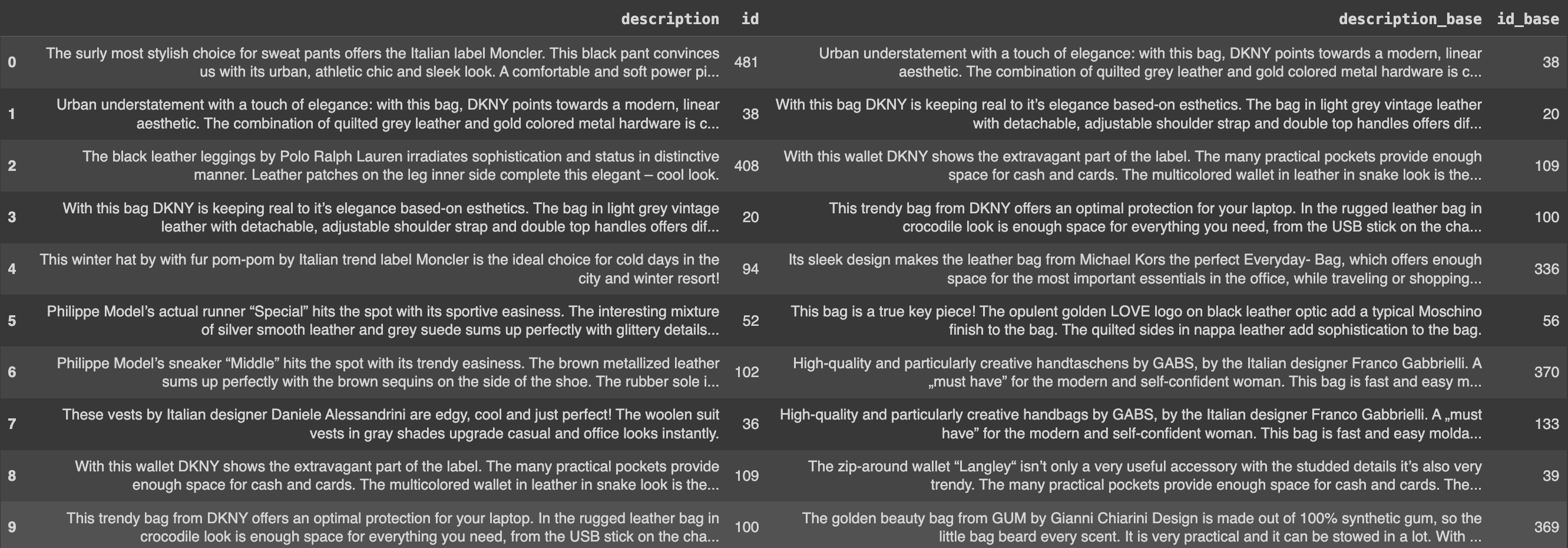
But if we weight the event-affected Spaces more heavily, we surface completely novel items in our recommendations list.
# with larger weight on the the event-affected spaces, more totally new items appear in the TOP10 event_weighted_result = app_with_events.query( personalised_query, user_id="user_1", query_text="", description_weight=5, category_weight=1, name_weight=1, price_weight=1, review_count_weight=1, review_rating_weight=1, limit=TOP_N, ) event_weighted_result.to_pandas().join( simple_result.to_pandas(), lsuffix="", rsuffix="_base" )[["description", "id", "description_base", "id_base"]]
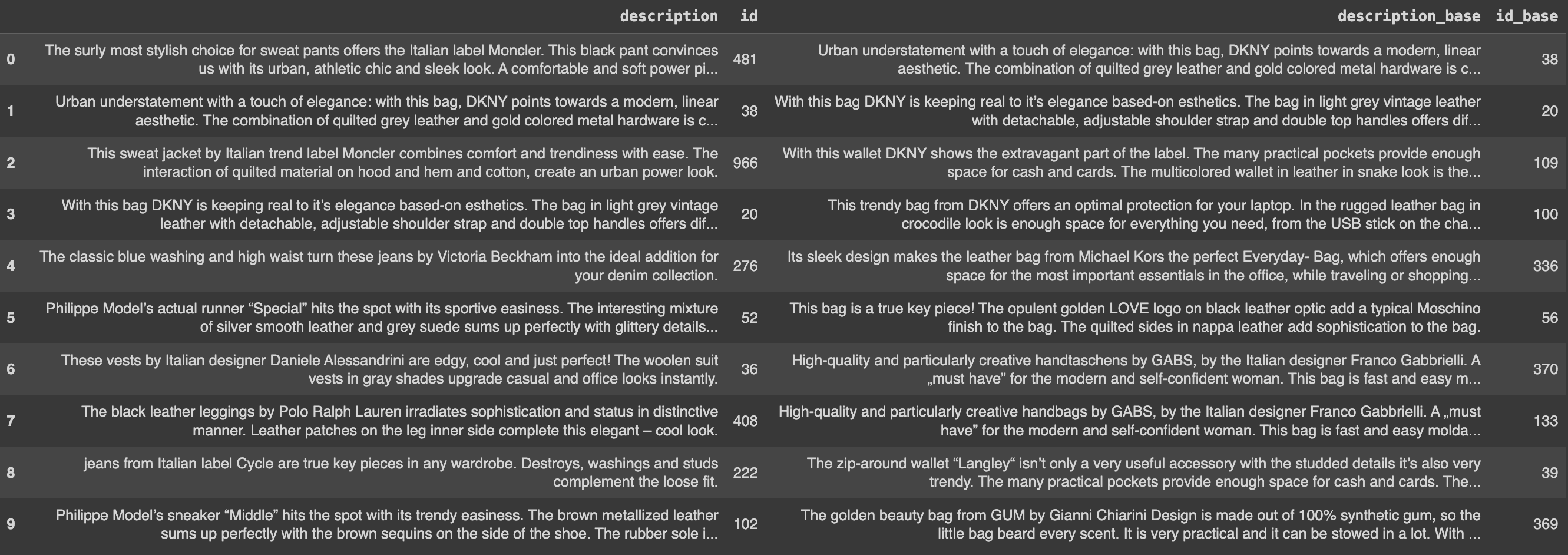
We can also, of course, use weights to personalize our recommendations based on a particular user's behavior (event data) and simultaneously prioritize other product attributes - for example, price (see cell 31).
The eComm RecSys implementation of the Superlinked library (above) shows you how to realize the power of vector embeddings by incorporating the semantic meaning of user queries and behavioral data. Using our min_max number and text-similarity Spaces, Events schema and Effects, and query time weights, you can address the cold-start, quality and relevance, and scalability challenges of RecSys and provide highly accurate, user-personalized recommendations in production.
Now it's your turn! Try implementing the Superlinked library yourself using our notebook.
Stay updated with VectorHub
Continue Reading